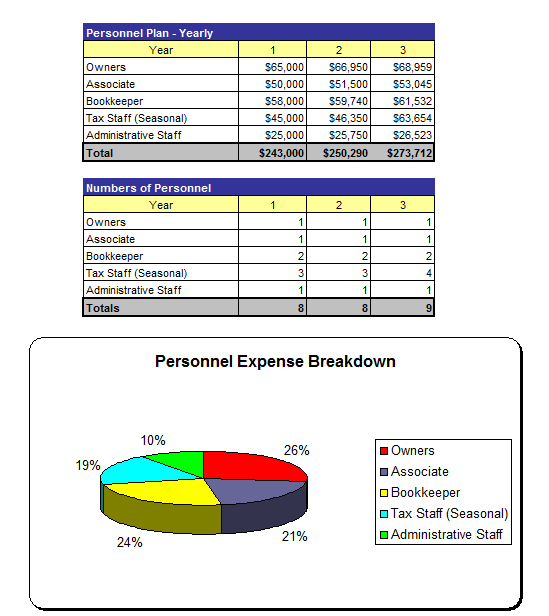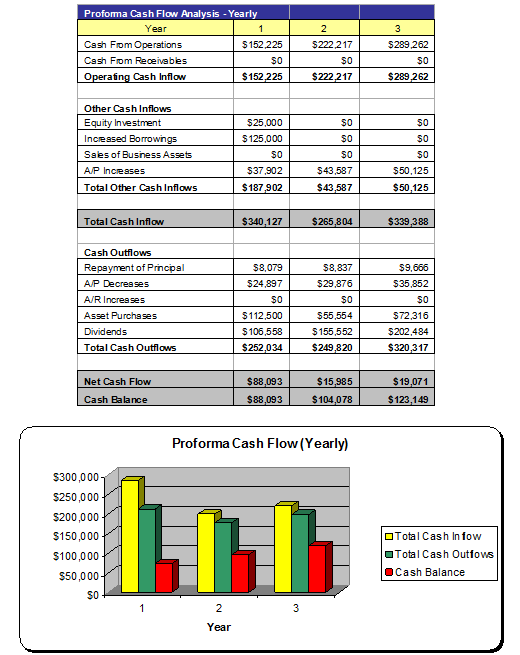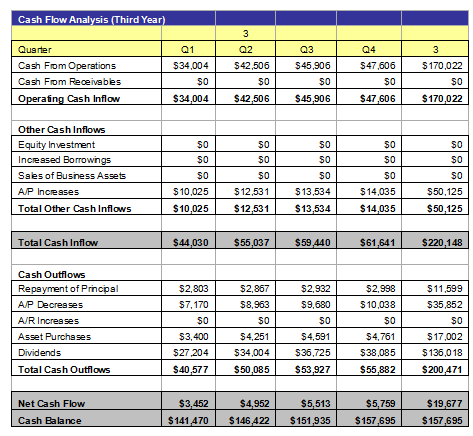Free Summer Camp Business Plan
For Raising Capital from Investors, Banks, or Grant Companies!
Please note that the financials
in this complete free business plan are completely fictitious and may not
match the text of the business plan below. This free business plan demonstration
purposes only. If you are interested in purchasing the completed editable MS Word
and Excel documents for this business plan, please click the button below! Also,
the text of the business plan is formatted with a fully automated
table of contents.
Return to
Samples Page
It should be noted that there is no special software required to use these
templates. All business plans come in Microsoft Word and Microsoft Excel format.
Each business plan features:
- Excecutive Summary
- Company and Financing Summary
- Products and Services Overview
- Strategic Analysis with current research!
- Marketing Plan
- Personnel Plan
- 3 Year Advanced Financial Plan
- Expanded Financial Plan with Monthly Financials
- Loan Amortization and ROI Tools
- FREE PowerPoint Presentation for Banks, Investors,
or Grant Companies!
1.0 Executive Summary
The purpose of this business plan is to raise $50,000 for the development of a summer camp facility while showcasing the expected financials and operations over the next three years. Summer Camp, Inc. (“the Company”) is a New York
based corporation that will operate a summer camp during the months of June, July, and August to customers in its targeted market. The Company was founded by John Doe.
1.1 Products and Services
The primary revenue center for the business will come from the ongoing fees that are acquired from providing summer camp activities to children between the ages of 3 to 15 at the Summer Camp facility.
The business will earn its secondary revenues from registration fees, field trip fees, and other sources of income normally associated with Summer Camps.
The third section of the business plan will further describe the services offered by the Summer Camp.
1.2 The Financing
Mr. Doe is seeking to raise $50,000 from as a bank loan. The interest rate and loan agreement are to be further discussed during negotiation. This business plan assumes that the business will receive a 10 year loan with a 9% fixed interest rate. The financing will be used for the following:
-
Development of the Company’s Summer Camp location.
-
Financing for the first six months of operation.
-
Capital to purchaseequipment for the Summer Camp.
Mr. Doe will contribute $10,000 to the venture.
1.3 Mission Statement
The Summer Camp’s mission is to provide customers with an exciting and amusing summer camp experience.
1.4 Mangement Team
The Company was founded by John Doe. Mr. Doe has more than 10 years of experience in the
summer camp industry. Through his expertise, he will be able to bring
the operations of the business to profitability within its first year of
operations.
1.5 Sales Forecasts
Mr. Doe expects a strong rate of growth at the start of operations. Below are the
expected financials over the next three years.

1.6 Expansion Plan
The Founder expects that the business will aggressively expand during the first three years of operation. Mr. Doe intends to implement marketing campaigns that will effectively target individuals within the target market during the Summer season.
2.0 Company and Financing Summary
2.1 Registered Name and Corporate Structure
Summer Camp, Inc. The
Company is registered as a corporation in the State of
New York.
2.2 Required Funds
At this time, the Summer Camp requires $50,000 of debt funds. Below is a breakdown of how these funds
will be used:

2.3 Investor Equity
Mr. Doe is not seeking an
investment from a third party at this time.
2.4 Management Equity
John Doe owns 100% of Summer Camp, Inc.
2.5 Exit Strategy
If the business is very successful, Mr. Doe may seek to sell the business to a third party for a significant earnings multiple. Most likely, the Company will hire a qualified business broker to sell the business on behalf of the Summer Camp. Based on historical numbers, the business could fetch a sales premium of up to 2 times earnings plus the value of FF&E and real estate.
3.0 Products and Services
3.1 Summer Camp Services
As stated in the executive summary, the primary revenue center for the business will come from the ongoing usage of the Summer Camp among individuals between the ages of 3 to 15. Camp sessions will be held on a daily basis throughout the week with the exception of the weekends. Activities that will be held by the Summer Camp include, but are not limited to:
-
Regular field trips
-
Arts and crafts
-
Daily sports activities
-
Meal service
4.0 Strategic and Market Analysis
4.1 Economic Outlook
This section of the analysis will detail the economic climate, the summer camp industry, the customer profile, and the competition that the business will face as it progresses through its business operations.
Currently, the economic market condition in the United States is moderate. Unemployment rates have declined while asset prices have risen substantially. However, the Summer Camp is a highly specialized seasonal business and the pricing point associated with the Company’s services is very low. Additionally, many parents want to provide their children with a fun Summer, and as such, Management does not expect that the current economic climate will have a substantial impact on the Company’s ability to produce top line income.
4.2 Industry Analysis
Within the United States, there are approximately 2,000 businesses that operate one or more summer camp facilities. Each year, these businesses aggregately generate more than $2 billion of revenues and provide seasonal employment to 40,000 people. Annual payrolls in each of the last five years has exceeded $400 million.
The growth rate of this business is expected to remain in lockstep with that of the economy and population. There are approximately 2,000 companies in the United States that specialize in the Summer Camp operations.
4.3 Customer Profile
The Summer Camp’s average client will be a middle to upper middle class man or woman with children living in the Company’s target market. Common traits among clients will include:
-
Will spend $500 to $750 per month on summer camp activities.
-
Lives no more than 100 miles from the Company's summer camp loaction.
-
Annual household income exceeding $65,000.
4.4 Competitive Analysis
This is one of the sections of
the business plan that you must write completely on your own. The key to writing
a strong competitive analysis is that you do your research on the local
competition. Find out who your competitors are by searching online directories
and searching in your local Yellow Pages. If there are a number of competitors
in the same industry (meaning that it is not feasible to describe each one) then
showcase the number of businesses that compete with you, and why your business
will provide customers with service/products that are of better quality or less
expensive than your competition.
5.0 Marketing Plan
Summer Camp, Inc. intends to maintain an extensive marketing campaign that will ensure maximum visibility for the business in its targeted market. Below is an overview of the marketing strategies and objectives of the Company.
5.1 Marketing Objectives
-
Establish massive local campaigns during the months of May, June, July, and August.
-
Establish relationships with school counselors that will refer parents to the Summer Camp.
5.2 Marketing Strategies
Mr. Doe intends on using a number of marketing strategies that will allow the Summer Camp to easily target men and women (those with children) within the target market. These strategies include traditional print advertisements and ads placed on search engines on the Internet.
The Summer Camp will also use an internet based strategy. This is very important as many people seeking local businesses, such as Summer Camps, now the Internet to conduct their preliminary searches. Mr. Doe will register Summer Camp, Inc. with online portals so that potential customers can reach the business. The Company will also develop its own online website, which will include information about the Summer Camp location.
During the pre-Summer season, the Company will aggressively distribute mail flyers, place advertisements in local newspapers, and develop relationships with local school newsletter that offer advertising space. Many schools distribute “summer flyers” newsletters in the late Spring, and Management will aggressively seek to place advertisements in these circulars.
5.3 Pricing
In this section, describe the pricing of your services and products. You should provide as much
information as possible about your pricing as possible in this section. However,
if you have hundreds of items, condense your product list categorically. This
section of the business plan should not span more than 1 page.more than 1 page.
6.0 Organizational Plan and Personnel Summary
6.1 Corporate Organization

6.2 Organizational Budget

6.3 Management Biographies
In this section of the business plan, you should write a two to four paragraph biography
about your work experience, your education, and your skill set. For each owner or
key employee, you should provide a brief biography in this section.
7.0 Financial Plan
7.1 Underlying Assumptions
The Company has based its
proforma financial statements on the following:
-
The Summer Camp will
have an annual revenue growth rate of 10% per year.
-
The Owner will acquire $50,000
of debt funds to develop the business.
-
The loan will have a 10 year
term with a 9% interest rate.
7.2 Sensitivity Analysis
In the event of an economic downturn, the business may have a decline in its revenues. However, summer will continue to come every year, and children will still want to go to summer camps despite deleterious economic conditions. The high margin revenues generated from the sale of summer camp fees to the Summer Camp will ensure the business’ continued profitability on a year to year basis.
7.3 Source of Funds

7.4 General Assumptions

7.5 Profit and Loss Statements

7.6 Cash Flow Analysis

7.7 Balance Sheet
 .
.
7.8 General Assumptions

7.9 Business Ratios

Expanded Profit and Loss Statements




Expanded Cash Flow Analysis



